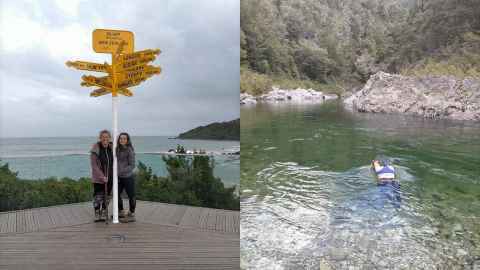Hikoi reveal impact of climate change on landscape over time
1 December 2023
Taking part in three hikoi over the years, Dr Phillipa Pehi has explored a te ao Māori worldview and the connection between tangata whenua and te taiao.

Having walked the length of Aotearoa on three separate hikoi since 2013, Dr Phillipa Pehi has borne witness to the impact that climate change is having on the landscape and the people she meets along the way.
“Over the time that I’ve walked, it seems like this is one of the issues that have increased, but people’s awareness has also increased – often out of necessity,” she says.
As a Research Fellow within the Faculty of Science’s new Ngā Motu Whakahī-Raising our Islands pilot programme , Phillipa is retracing her academic and professional footsteps as a clinical and social psychologist to rigorously examine how Māori and indigenous understandings and practices of health, wellbeing, and healing can inform, improve and offer alternative approaches to current mental health systems and practices.
I credit that hikoi with saving my life because I didn’t realise how burnt out and unwell I was from my clinical work, and it made me realise we still live in a beautiful country.
One of the central tenets of Māori culture is the belief that all within our world is interconnected and that people are descended from the environment, and Phillipa’s past research has investigated the link between the wellbeing of tangata whenua and the wellbeing of Te Taiao/the environment.
While she describes climate change as a “background issue” to her specific research, Phillipa says, “It was actually quite distressing, to say the least, to see what was happening to our environment and then seeing that in 60 to 70 years how we’ve totally destroyed so many ecosystems all around the world.”
The Canterbury Plains are a prime example. Once covered in trees and treasured by Māori for the swamps, which provided food and acted as a natural filtration system, she says that some places are now like “walking through a dust bowl” because of modern farming practices. “With the drastic alteration of the environment that’s come with climate change, that has affected Māori quite hugely, but it’s also affected a lot of New Zealanders in general.”
A key element of her overall research project will focus on hikoi as a potential pathway for healing, something that Phillipa has observed at a personal level by walking with both her daughter and sister. And she says that the four and a half months spent traversing the 3,000 kilometres of the country for the first time with her sister was literally the walk of a lifetime.
“I credit that hikoi with saving my life because I didn’t realise how burnt out and unwell I was from my clinical work, and it made me realise we still live in a beautiful country. Yes, we’ve got issues, but it’s still a beautiful country with many beautiful people.”
In many respects, Phillipa says that her walks are a response to climate change and climate justice.
“I wouldn’t say my project is focused on climate justice, but it’s driven by it,” she says. “It’s looking for community resilience, and it’s looking for community adaptation to these challenges. It’s also addressing some of the social aspects around it as well. Who is it affecting more?”
This story first appeared in InSCight 2023. Read more InScight stories.